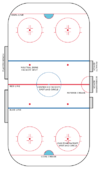Two-way forward
In ice hockey, a two-way forward is a forward who handles the defensive aspects of the game as well as the offensive aspects. Typically, a player's frame is not an issue in whether he can be a two-way forward. Perseverance is key to being a two-way forward, as it is an attribute that gives rise to battling in the corners or preventing odd-man rushes by the opposing team. A two-way forward can contribute for the team both offensively and defensively, scoring important game-winning goals or making big plays from which his team receives a significant advantage over the opponent team. As such, good two-way forwards are often capable playmakers.
Two-way forwards are sometimes left in the shadows of star players, but commentators often reiterate their importance to a team. The National Hockey League (NHL) presents its best two-way forward with the Frank J. Selke Trophy, awarded to the forward "who demonstrates the most skill in the defensive component of the game".
Active winners and nominees of the Selke Trophy
- Pavel Datsyuk, Detroit Red Wings. Won in 2008, 2009 and 2010. Nominated in 2011 and 2012
- Ryan Kesler, Vancouver Canucks. Nominated in 2009 and 2010. Won in 2011
- Mike Richards, Philadelphia Flyers. Nominated in 2009
- Jordan Staal, Pittsburgh Penguins. Nominated in 2010
- Jonathan Toews, Chicago Blackhawks. Nominated in 2011. Won in 2013
- Henrik Zetterberg, Detroit Red Wings. Nominated in 2008
- David Backes, St. Louis Blues. Nominated in 2012
- Patrice Bergeron, Boston Bruins. Won in 2012
| Positions on the hockey rink | ||||||
|---|---|---|---|---|---|---|
| Forwards: |  |
| ||||
| Defencemen: | | |||||
| Goaltender: | | |||||
| Power forward | Enforcer | Grinder | Pest | Captain | Head coach | Referee & linesman | ||||||